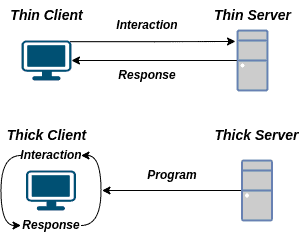1. Introduction
The use of distributed systems is rapidly increasing in the modern computing world. The distinction between thin and thick clients is one of the features of distributed systems.
In this tutorial, we’ll review the differences between thin and thick clients, their benefits and drawbacks, and reasons for their significance in distributed systems.
2. Thin Clients
In a distributed system, a thin client is a type of client that performs most of its processing on the server. A thin client is a hardware device with only a small amount of memory and processing power. A thin client relies entirely on the server, so when new data appears, it simply requests the central server to take over.
The greater part of the application handling and data storage operations are carried out by the servers for thin clients. Smartphones and browsers for the Internet are two instances of thin clients.
There is no demand for costly devices on the client side because most work is done on the server. The client devices are furthermore basic enough to be easily updated and maintained. Since more clients may be added to the system without significantly altering the server architecture, thin clients are also very scalable.
Thin clients can have certain drawbacks, though. Because the server handles almost all of the computation, network latency might become a serious problem. The performance of the program can decrease if the network connection between the client and server is poor. Because they depend on the server for user access and identification control, thin clients may also be exposed to security risks.
3. Thick Clients
On the other hand, a thick or fat client is a type of distributed system architecture that is mostly independent of the central server. Although a thick client requires a periodic connection to the server, it is able to handle many operations without any additional connection due to its large processing and memory capabilities. Gaming consoles and desktop software are two examples of thick clients.
Thick clients’ primary benefit is their capacity to handle complicated processing tasks independently of the server. Therefore this architecture provides a more dynamic user interface. Thick clients can also keep working even if the network connection to the server is broken since they can complete numerous tasks independently.
However, there are drawbacks when dealing with thick clients. They may cost more to set up since they need more processing power and memory. In addition, they can be more challenging to manage and upgrade because they carry out numerous functions independently. Furthermore, thick clients are not as scalable as thin clients since adding more clients necessitates substantial modifications to the server architecture.
4. Comparison of Thin and Thick Clients
Thin and thick clients serve critical roles in distributed systems. They each have various benefits and drawbacks, and the decision between them is determined by the application’s unique requirements:
 A summary of the differences between thin and thick clients:
A summary of the differences between thin and thick clients:
Features
Thin Clients
Thick Clients
Processing Power
Minimal
Substantial
Data Storage
Minimal
Substantial
Network Dependency
High
Low
Maintenance
Low
High
Cost
Low
High
Security
High
Low
User Experience
Basic
Rich
5. Conclusion
When constructing a distributed system, developers should be aware of the distinctions between thin and thick clients in order to increase the system’s performance.
In this article, we walked through thin and thick clients in distributed systems, analyzed their differences, and highlighted their main advantages and disadvantages.